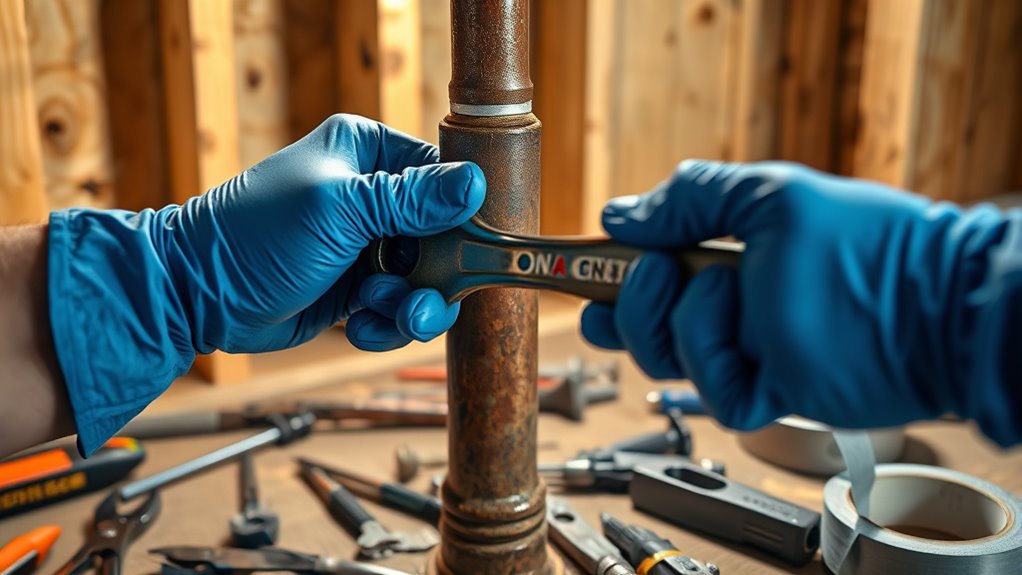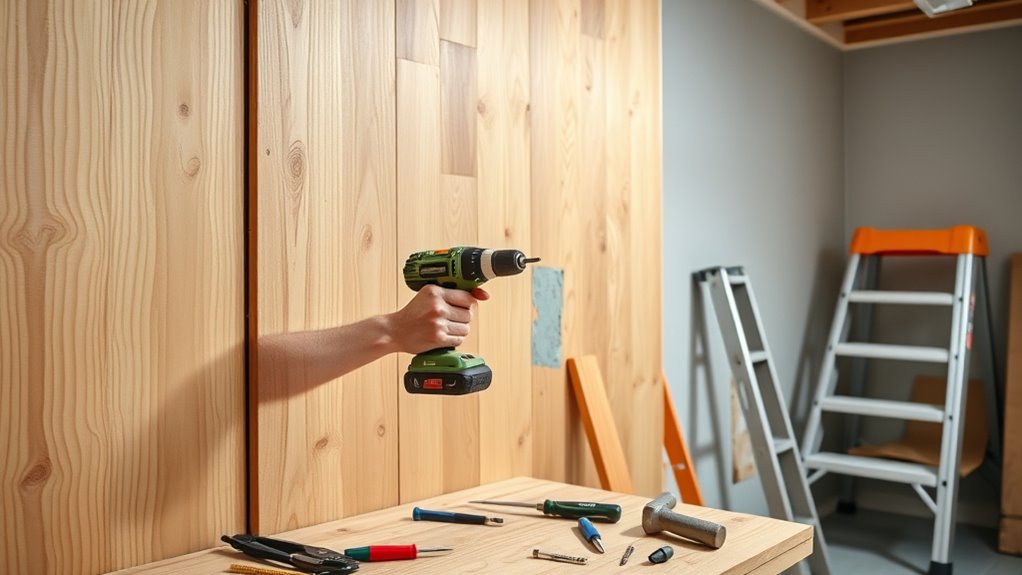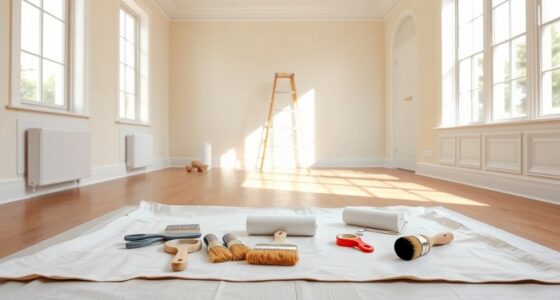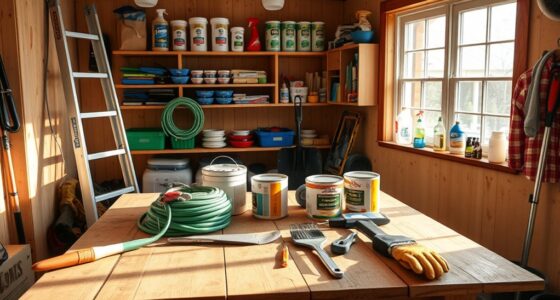To start DIY home repairs, gather essential tools like screwdrivers, a hammer, level, tape measure, and cordless drill. Plan each project carefully, assess the problem, and gather materials beforehand to avoid mistakes. Always prioritize safety with glasses and tidy workspaces. Take your time, follow tutorials, and don’t be afraid to ask for advice. With proper preparation, you’ll build confidence and learn effective ways to maintain your home—more tips are just ahead.
Key Takeaways
- Gather essential tools like screwdrivers, hammer, and tape measure to handle most small repairs safely and effectively.
- Plan and assess the problem thoroughly before starting to choose the right tools and materials.
- Follow safety precautions such as wearing safety glasses and keeping your workspace organized.
- Avoid common mistakes like rushing, improvising, or using incorrect tools to prevent damage and injury.
- Use tutorials or seek professional advice when needed to ensure proper technique and durable results.

Are you ready to tackle home repairs on your own? Diving into DIY projects can be rewarding, but it’s essential to start with the right tools and knowledge to avoid common mistakes. Before you pick up a hammer or screwdriver, take a moment to gather the tools needed for basic repairs. A good beginner toolkit should include a hammer, screwdrivers (both flat-head and Phillips), a tape measure, pliers, a utility knife, a level, and a cordless drill. These essentials will cover most small projects around the house, from fixing a leaky faucet to hanging shelves. Investing in quality tools might cost a bit upfront, but they’ll last longer and make your work easier.
When you’re just starting, it’s common to make mistakes that can set you back or even cause damage. One common mistake is rushing into a repair without proper planning. Take the time to assess the problem and gather all necessary tools and materials before beginning. Skipping this step can lead to incomplete repairs or using the wrong tools, which might damage surfaces or hardware. Another mistake is neglecting safety precautions. Always wear safety glasses when drilling or sanding, and keep your workspace tidy to prevent accidents. Using the wrong tool for a task is also a frequent error. For example, using a butter knife instead of a flat-head screwdriver may seem handy, but it’s unlikely to provide enough torque or grip. Using the incorrect tool can damage fasteners or strip screws, making future repairs more difficult.
Another common mistake involves over-tightening fasteners. It’s tempting to tighten screws or bolts until they feel secure, but overdoing it can crack drywall, strip threads, or damage materials. Practice applying just enough pressure until the fastener is snug. Additionally, many beginners underestimate how long repairs can take or how complex certain tasks are. Rushing through a project might seem efficient, but it often leads to mistakes or subpar results. Be patient and don’t hesitate to consult tutorials, guides, or professionals if you’re unsure. Finally, avoid improvising with incompatible materials or tools. For example, using nails instead of screws in certain situations might work temporarily but won’t hold as well long-term. To ensure safe and effective repairs, consider proper planning and preparation, which can help prevent mistakes and improve your overall results.
Frequently Asked Questions
How Do I Prioritize Repairs in My Home?
You should start by evaluating your home’s needs through a thorough home inspection. Identify urgent repairs like leaks or electrical issues that impact safety. Then, create a repair schedule prioritizing these critical fixes first. By organizing repairs based on urgency and importance, you ensure safety and efficiency. Regularly reviewing and adjusting your repair schedule helps you stay on top of maintenance and prevent small problems from becoming costly repairs later.
What Safety Equipment Is Essential for DIY Repairs?
When tackling DIY repairs, you need to prioritize safety by wearing essential protective gear. Always use safety precautions like goggles to protect your eyes, gloves for your hands, and a dust mask if you’re sanding or working with fumes. Hearing protection is crucial when using loud tools. This gear keeps you safe from potential injuries, ensuring your DIY projects are both successful and accident-free.
How Can I Estimate Costs for Home Maintenance Projects?
Imagine your home as a treasure chest, and each repair is a gem you want to value. To estimate costs, start with budget planning by listing needed supplies and labor. Research prices online or at stores, then add a buffer for unexpected expenses. Keep detailed records for cost tracking, which helps you stay on budget and prepare better for future projects. This way, you turn home maintenance into a manageable, rewarding adventure.
When Should I Hire a Professional Instead of DIY?
You should hire a professional when a project involves complex work, safety risks, or costly mistakes. For cost-effective upgrades and seasonal maintenance tips, DIY might be suitable, but if you’re unsure or the task exceeds your skills, it’s better to call in experts. This guarantees quality results, saves money in the long run, and helps avoid potential hazards, especially for projects requiring specialized tools or knowledge.
How Do I Find Reliable Tutorials for Complex Repairs?
To find reliable tutorials for complex repairs, start by searching for video tutorials from reputable sources like well-known DIY websites or professional channels. Check for expert reviews or comments to gauge credibility. Look for detailed, step-by-step instructions and clear visuals. Avoid videos with poor audio or unclear visuals. Trust tutorials that come from experienced DIYers or professionals, and always cross-reference with multiple sources to verify accuracy before starting your project.
Conclusion
Now that you’re equipped with basic DIY skills, tackling home repairs becomes less intimidating. Remember, patience and a can-do attitude are your best allies—think of yourself as a modern-day MacGyver, ready to fix anything that comes your way. With each repair, you’ll gain confidence and a sense of pride, transforming your house into a true home. So roll up your sleeves and embrace the adventure—your castle is waiting for your touch!










